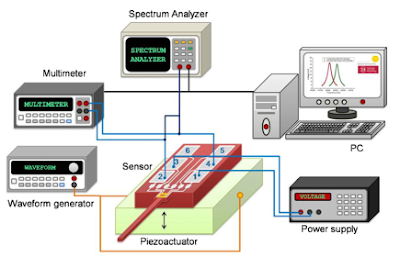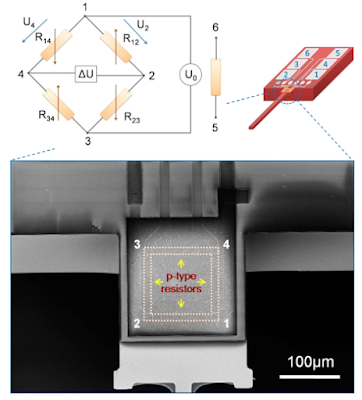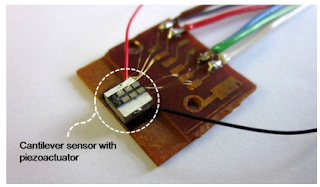Airborne Engineered Nanoparticle Mass Sensor Based on a Silicon Resonant Cantilever - Recently, there is increasing awareness about uncertainties concerning the risk of released nanoparticles (NPs) to the environment during the widespread use of nanotechnology which is well-recognized to be profitable for a human beings. Various types of NPs, e.g., carbon, silver, gold, TiO2, and SiO2 are utilized and included in industrial and commercial products used in daily life, e.g., food packaging, cosmetics, pharmaceuticals, medical devices, odor-resistant textiles, and household appliances. From numerous studies, it is known that inhalation is probably the major route of human exposure to NPs.
Read More :
Cavity Magnon-polaritons in Cuprate Parent Compounds (Published 15 June 2021)
Detecting Dark Matter Meets Atomic, Molecular, and Optical Physics in New Research
2022 Basic of Spintronics (Giant Magnetoresistance Basics)
Depending on their size, shape, density, and surface properties inhaled NPs are deposited in all regions of the respiratory tract [4]. All particles smaller than 10-micrometer in diameter (PM10) were found to have the possibility of being biologically active in susceptible individuals. However, the adverse health effects per unit particle mass of ultrafine particles (<300 nm), which are in the same size range as engineered NPs, can be higher than that of fine particles (PM10 or PM2.5). There are several sources for engineered NPs in workplaces and in the indoor environment.
The potential risk to human health becomes of particular concern to workers employed by the nanomaterial industries where consumer products are manufactured that contain engineered NPs during the manufacturing stage. Although the effect of NPs in the respiratory tract is mainly related to the surface, most epidemiological studies refer to the inhaled mass. Guidelines as defined by the World Health Organization for PM10 and PM2.5 in ambient air also use mass-related units. Especially in the case of NPs, calculation of the particle mass concentration from counting techniques (e.g., Mie scattering and scanning mobility particle sizer) bears large uncertainties. Therefore, direct mass sensing of airborne nanoparticles is very useful for the assessment of personal and location-dependent monitoring in workplaces and the indoor environment.
The development of low-cost and portable sensors for monitoring and assessing airborne engineered NPs exposure can be greatly assisted with the use of micro-electro-mechanical systems (MEMS) based resonators. Such sensors are able to count the cumulative mass of particles deposited on their surfaces as a shift in their resonant frequencies with high measuring precision. A mass of ∼115 pg was able to be resolved using a thermally excited MEMS resonator. However, mass sensitivity characterization was restricted to particles of ∼1-micrometer in diameter deposited on the resonator under partial vacuum conditions. Mass sensitivity of 3.33 Hz/fg was achieved in another work which utilized a mass sensor based on an electrostatically driven resonant cantilever experimented in measurements with 1-micrometer glycerin beads. For sensor fabrication, silicon-on-insulator wafers (SOI) were used which is expensive with respect to standard silicon.
Moreover, the thickness of an SOI wafer is fixed at a certain value, hence the degree of freedom for sensor design is restricted concerning optimization of sensor dimensions. From the previous work, a piezoelectrically actuated resonant sensor based on AlN sputter-deposited Si cantilever has been found to be able to detect very small resonant frequency shift caused by deposited ∼100 nm carbon particles (i.e., 0.31 Hz). However, the integration of a piezoelectric thin film with the micromechanical elements requires a rather complicated fabrication process due to material characterization and quality control issues.
In this study, MEMS cantilever-based resonators are fabricated and investigated as sensors for detecting engineered carbon NPs (<200 nm) in a test chamber under typical workplace conditions. Carbon NPs are used as a model system of an engineered aerosol which is widely used in electronic devices, electrochemical devices (e.g., supercapacitors and batteries), separation membranes, filled polymer composites, and drug-delivery systems. Like with all resonant mass sensors, the shift in resonant frequency due to the added mass of NPs is measured. The oscillation of the cantilever is detected by a self-sensing method using an integrated full Wheatstone bridge as a piezoresistive strain gauge for signal readout. It is driven by a low-voltage actuated piezoelectric stack and offers simplicity, a large output signal (mV, without amplification), low-power consumption, and high sensitivity. Results of detecting airborne engineered NP mass are presented and analyzed in this paper. The influences of ambient temperature, relative humidity, and pressure on the sensor have also been investigated with the purpose of observing the limitation of sensor sensitivity imposed by the environment.
A silicon resonant cantilever sensor is developed for the detection of airborne nanoparticles (NPs) by monitoring the change in resonant frequency induced by an additional mass of trapped NPs. A piezoelectric stack actuator and a piezoresistive strain gauge are involved in the sensor system in order to actuate and detect the oscillation of the cantilever sensor, respectively. An electrostatic precipitator is employed to trap the NPs on the cantilever surface. The proposed sensor reveals a mass sensitivity of 10 Hz/ng and a quality factor of 1206 while operated in the fundamental flexural mode. As necessary for an application under workplace conditions the limitations of the sensor sensitivity imposed by the environment are investigated, i.e., the influences of temperature, relative humidity, and pressure on the sensor are measured
Conclusion
Silicon resonant cantilever sensors with the integrated piezoresistive bridges have been designed and fabricated for airborne engineered NP mass sensing. The cantilever sensors are combined with an electrostatic precipitator to enhance the NP collection efficiency. The presented method and device are proven to be able to monitor and measure the mass of adsorbed airborne engineered NPs under normal ambient conditions. By means of the presented experimental results of NP sampling with a total concentration of 3000 particles/cm3 maintained for 24 h, the sensor exhibits low cross-sensitivity of <3% due to environmental effects with respect to temperature change of <2 ◦C, relative humidity change of <20%, and pressure change (<20 kPa). For being implemented in real workplace conditions and online sensing performance, sensor geometry, detection method, and NP collection system have to be optimized in order to increase quality factor, mass sensitivity, sensing resolution, and sampling efficiency.
READ MORE ABOUT TECHNOLOGY :
Quantum Teleportation with Imperfect Quantum Dots
Plastics to Fuel in New Generation- Technology Pyrolysis
References
S. Merzsch, H.S. Wasisto, Ü. Sökmen, A. Waag, E. Uhde, T. Salthammer, E. Peiner, Mass measurement of nanoscale aerosol particles using a piezoelectrically actuated resonant sensor, in IEEE Sensors 2010 Conf., 2010.
E. Peiner, L. Doering, A. Stranz, Surface finish improvement of deep micro bores monitored using an active MEMS cantilever probe, in: Proc. IEEE-ICIT 2010 Conf., 2010, pp. 297–302.
H.S. Wasisto, S. Merzsch, A. Stranz, A. Waag, E. Uhde, I. Kirsch, T. Salthammer, E. Peiner, Use of self-sensing piezoresistive Si cantilever sensor for determining carbon nanoparticle mass, Proceedings of SPIE 8066 (2011) 806623.
J. Lübbe, M. Temmen, H. Schnieder, M. Reichling, Measurement and modeling of non-contact atomic force microscope cantilever properties from ultra-high vacuum to normal pressure conditions, Measurement Science and Technology 22 (2011), 055501 (6 pp.).
























